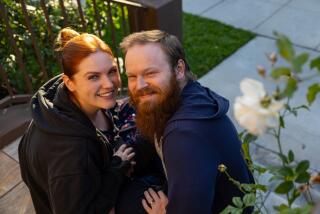82 ‘Miracle’ Children : Doctor’s Picnic Is Celebration of Life
- Share via
The Mother’s Day picnic celebration Friday in Santa Ana’s Cabrillo Park nearly didn’t happen for most of the 60 mothers who attended with their 82 children.
The majority of the mothers had spent up to five years trying to get pregnant.
“This is going to be our miracle baby,” said 7-months-pregnant Susie James, 25, of Yorba Linda, who was walking gingerly about the milling crowd of tots. “I have to be careful because I just can’t go home and make another one.”
It took James five years to become pregnant.
At the same time, Sharron and Mike Ducross of Costa Mesa were the hit of the picnic with their 12-week-old identical twin sons--the result, they said, of four years of difficult testing and costs that ran $5,000 more than what their insurance covered.
‘Difficult and Expensive’
“There were times when we thought it wouldn’t ever happen,” said a beaming Sharron Ducross, who is 33. “But Dr. (Ari) Babaknia kept urging us to continue. He knew some day it would work.”
Repeating a story similar to that told by many of the mothers, she said, “We finally went out to seek help when I couldn’t get pregnant, and even when we got the help, the whole process was really difficult and expensive.” Ducross said one month’s supply of pills once cost $100. “At times, we felt like quitting, but we kept going.”
In addition to becoming “scheduled” lovers--following a fertility program involving certain days of the month and certain body temperatures when sexual intercourse was prescribed, “we had a lot of pressure from people who would keep asking us when we we going to have children. Until I finally got pregnant, it was a hardship filled with a lot of stress.”
Babaknia, who sponsored the Mother’s Day picnic with a massive cake, balloons, carnations for the mothers and milk for the babies, calls the group “my family.” He spent most of the two-hour celebration holding babies, kissing mothers and posing for pictures.
Progress in Research
A bachelor who says he someday plans to have “at least five children,” Babaknia said, “All of these women have gone through a difficult process, but we’re starting to get better results.”
Inadequate ovulation, low sperm count, hormonal imbalances and inability of a woman’s egg to travel through blocked Fallopian tubes are the causes of 35% of the infertility problems Babaknia said he has encountered in the more than 200 couples he has treated.
He said infertility research, conducted nationwide and through the Southern California Infertility Institute he founded five years ago in Santa Ana, is making new gains.
“We know about 7% of all women have infertility problems, but we know we can help at least half of them to get pregnant,” said Babaknia, a gynecologist and obstetrician who delivered most of the children at the celebration.
“As time goes by, we’re finding new methods, new drugs and new treatment to cut the 50% figure.”
But just as important, he said, “Men and women out there who think they’re alone with their infertility problem have to reach out for help. With new technology and drugs, we’re making great strides.”
Later Pregnancy Popular
Part of the overall infertility problem, he said, involves the fact that women are having children later in life, a phenomenon he says now seems to be receding: “It seems having babies at a younger age is coming back.”
He also noted a trend to reversal of tubal ligations, a popular form of birth control among women during the 1970s.
“Women are most fertile at age 25, and (after that age) being able to conceive starts dropping rapidly,” said Babaknia, who received his training at Johns Hopkins Hospital, Baltimore, and UC San Diego Medical Center.
“But even 60% of the women who have the (tubal ligation) reversal are becoming pregnant.”
More to Read
Sign up for Essential California
The most important California stories and recommendations in your inbox every morning.
You may occasionally receive promotional content from the Los Angeles Times.













